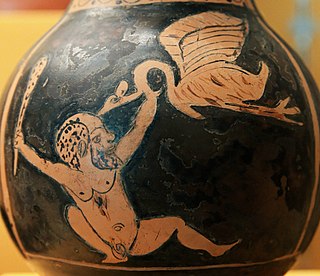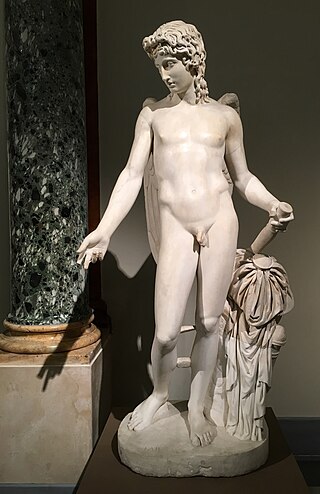Related Research Articles

The Acheron is a river in the Epirus region of northwest Greece. It is 52 km (32 mi) long, and has a drainage area of 705 km2 (272 sq mi). The river's source is located near the village Zotiko, in the southwestern part of the Ioannina regional unit. The Acheron flows into the Ionian Sea in Ammoudia, near Parga.

In ancient Greek religion and mythology, the Moirai —often known in English as the Fates—were the personifications of destiny. They were three sisters: Clotho, Lachesis, and Atropos. Their Roman equivalent is the Parcae.

In Greek mythology, Charon or Kharon is a psychopomp, the ferryman of the Greek underworld. He carries the souls of those who have been given funeral rites across the rivers Acheron and Styx, which separate the worlds of the living and the dead. Archaeology confirms that, in some burials, low-value coins known generically as Charon's obols were placed in, on, or near the mouth of the deceased, or next to the cremation urn containing their ashes. This has been taken to confirm that at least some aspects of Charon's mytheme are reflected in some Greek and Roman funeral practices, or else the coins function as a viaticum for the soul's journey. In Virgil's epic poem, Aeneid, the dead who could not pay the fee, and those who had received no funeral rites, had to wander the near shores of the Styx for one hundred years before they were allowed to cross the river. Charon also ferried the living mortals Heracles and Aeneas to the underworld and back again.
Agoracritus was a famous sculptor in ancient Greece.
Crotopus or Krotopos, in Greek mythology, was the eighth king of Argos.

In ancient Greek religion and myth, Nemesis also called Rhamnousia, was the goddess who personified retribution for the sin of hubris: arrogance before the gods.

Lamia, in ancient Greek mythology, was a child-eating monster and, in later tradition, was regarded as a type of night-haunting spirit or "daimon".
In Roman and Greek mythology, Carpus is a minor character associated with fertility and springtime. Similarly, Karpo, one of the Horae, is the feminine equivalent of Karpos; her dominion being the fruits of the earth.

In ancient Greek religion and myth, the Anemoi were wind gods who were each ascribed a cardinal direction from which their respective winds came, and were each associated with various nature, seasons and weather conditions. They were the progeny of the goddess of the dawn Eos and her husband, the god of the dusk, Astraeus.

Gerana, sometimes also called Oenoe, is a queen of the Pygmy folk in Greek mythology, who incurred the wrath of the goddess Hera and was subsequently turned into a bird bearing her name, the crane. This aetiological tale explains the ancient rivalry between the Pygmies and the cranes, and also serves as a cautionary tale against the people who hubristically claimed to be better than even the gods themselves. Gerana's story bears some resemblance to that of Lamia, who was also a beautiful woman cursed by Hera and transformed into something unappealing.

In Greek mythology, Eros is the Greek god of love and sex. His Roman counterpart is Cupid ('desire'). In the earliest account, he is a primordial god, while in later accounts he is described as one of the children of Aphrodite and Ares and, with some of his siblings, was one of the Erotes, a group of winged love gods.
In Greek mythology, Soteria was the goddess or spirit (daimon) of safety and salvation, deliverance, and preservation from harm. Soteria was also an epithet of the goddesses Persephone and Hecate, meaning deliverance and safety.
Psamathe, sometimes given only as the daughter of Crotopus, was the daughter of King Crotopus of Argos, who became the lover of the god Apollo.

In Greek mythology, Amaracus was a young Cypriot boy who transformed into a marjoram plant, an aromatic herb that was one of Aphrodite's most commonly associated plants.
In Greek mythology, Achilleus, also spelled Achilles, was the son of Zeus and Lamia, and the main subject of a minor myth. He is not to be confused with the more famous Achilles, the hero of the Trojan War.
In Greek mythology Smilax was the name of a nymph who was in love with Crocus and was turned into the plant bearing her name. Ancient sources with information about her and her tale are few and far between.
In Nonnus's fifth-century AD epic poem the Dionysiaca, Pyrrhus is a minor figure from Asia Minor who was punished by the goddess Rhea, the mother of the gods, for his attempted assault of her. His short story is only mentioned in passing, without much elaboration.
In Greek and Roman mythology, Peristera is a nymph who was transformed into a dove, one of Aphrodite's sacred birds and symbols, explaining the bird's connection to the goddess. This myth survives in the works of Latin grammarian Lactantius Placidus and the first of the three anonymous Vatican Mythographers, whose works were discovered in a single manuscript in 1401.
In Greek mythology Nyctaea is a princess featuring in two stories about father-daughter incest, who is eventually turned into an owl by the goddess Athena. Both her tales are preserved in the works of pseudo-Lactantius Placidus, a Latin grammarian of the third century AD.
References
- ↑ Atsma, Aaron. "Poine". Theoi Project. Retrieved 2013-04-08.
- ↑ Irwin, Patrick. "Nemesis". University of Oxford. Archived from the original on 2010-10-02. Retrieved 2013-04-08.
- ↑ A Dictionary of Greek and Roman biography and mythology, Poena
 This article incorporates text from this source, which is in the public domain .
This article incorporates text from this source, which is in the public domain . - ↑ Harper, Douglas. "Penal - Etymology". Online Etymology Dictionary. Retrieved 2013-04-08.
